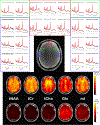High-quality lipid suppression and B0 shimming for human brain 1H MRSI
- PMID: 39276817
- PMCID: PMC11540284
- DOI: 10.1016/j.neuroimage.2024.120845
High-quality lipid suppression and B0 shimming for human brain 1H MRSI
Abstract
Magnetic Resonance Spectroscopic Imaging (MRSI) is a powerful technique that can map the metabolic profile in the brain non-invasively. Extracranial lipid contamination and insufficient B0 homogeneity however hampers robustness, and as a result has hindered widespread use of MRSI in clinical and research settings. Over the last six years we have developed highly effective extracranial lipid suppression methods with a second order gradient insert (ECLIPSE) utilizing inner volume selection (IVS) and outer volume suppression (OVS) methods. While ECLIPSE provides > 100-fold in lipid suppression with modest radio frequency (RF) power requirements and immunity to B1+ field variations, axial coverage is reduced for non-elliptical head shapes. In this work we detail the design, construction, and utility of MC-ECLIPSE, a pulsed second order gradient coil with Z2 and X2Y2 fields, combined with a 54-channel multi-coil (MC) array. The MC-ECLIPSE platform allows arbitrary region of interest (ROI) shaped OVS for full-axial slice coverage, in addition to MC-based B0 field shimming, for robust human brain proton MRSI. In vivo experiments demonstrate that MC-ECLIPSE allows axial brain coverage of 92-95 % is achieved following arbitrary ROI shaped OVS for various head shapes. The standard deviation (SD) of the residual B0 field following SH2 and MC shimming were 25 ± 9 Hz and 18 ± 8 Hz over a 5 cm slab, and 18 ± 5 Hz and 14 ± 6 Hz over a 1.5 cm slab, respectively. These results demonstrate that B0 magnetic field shimming with the MC array supersedes second order harmonic capabilities available on standard MRI systems for both restricted and large ROIs. Furthermore, MC based B0 shimming provides comparable shimming performance to an unrestricted SH5 shim set for both restricted, and 5-cm slab shim challenges. Phantom experiments demonstrate the high level of localization performance achievable with MC-ECLIPSE, with ROI edge chemical shift displacements ranging from 1-3 mm with a median value of 2 mm, and transition width metrics ranging from 1-2.5 mm throughout the ROI edge. Furthermore, MC based B0 shimming is comparable to performance following a full set of unrestricted spherical harmonic fields up to order 5. Short echo time MRSI and GABA-edited MRSI acquisitions in the human brain following MC-shimming and arbitrary ROI shaping demonstrate full-axial slice coverage and extracranial lipid artifact free spectra. MC-ECLIPSE allows full-axial coverage and robust MRSI acquisitions, while allowing interrogation of cortical tissue proximal to the skull, which has significant value in a wide range of neurological and psychiatric conditions.
Keywords: B0 field shimming; ECLIPSE; GABA-MRSI, GOIA; Human brain; Lipid suppression; MRSI; Multicoil; Proton MRSI, OVS.
Copyright © 2024. Published by Elsevier Inc.
Conflict of interest statement
Declaration of competing interest The authors have no competing interests (financial or personal) to disclose.
Figures








References
-
- Aghaeifar A, Zhou J, Heule R, et al., 2020. A 32-channel multi-coil setup optimized for human brain shimming at 9.4T. Magn. Reson. Med. 83 (2), 749–764. - PubMed
MeSH terms
Substances
Grants and funding
LinkOut - more resources
Full Text Sources

